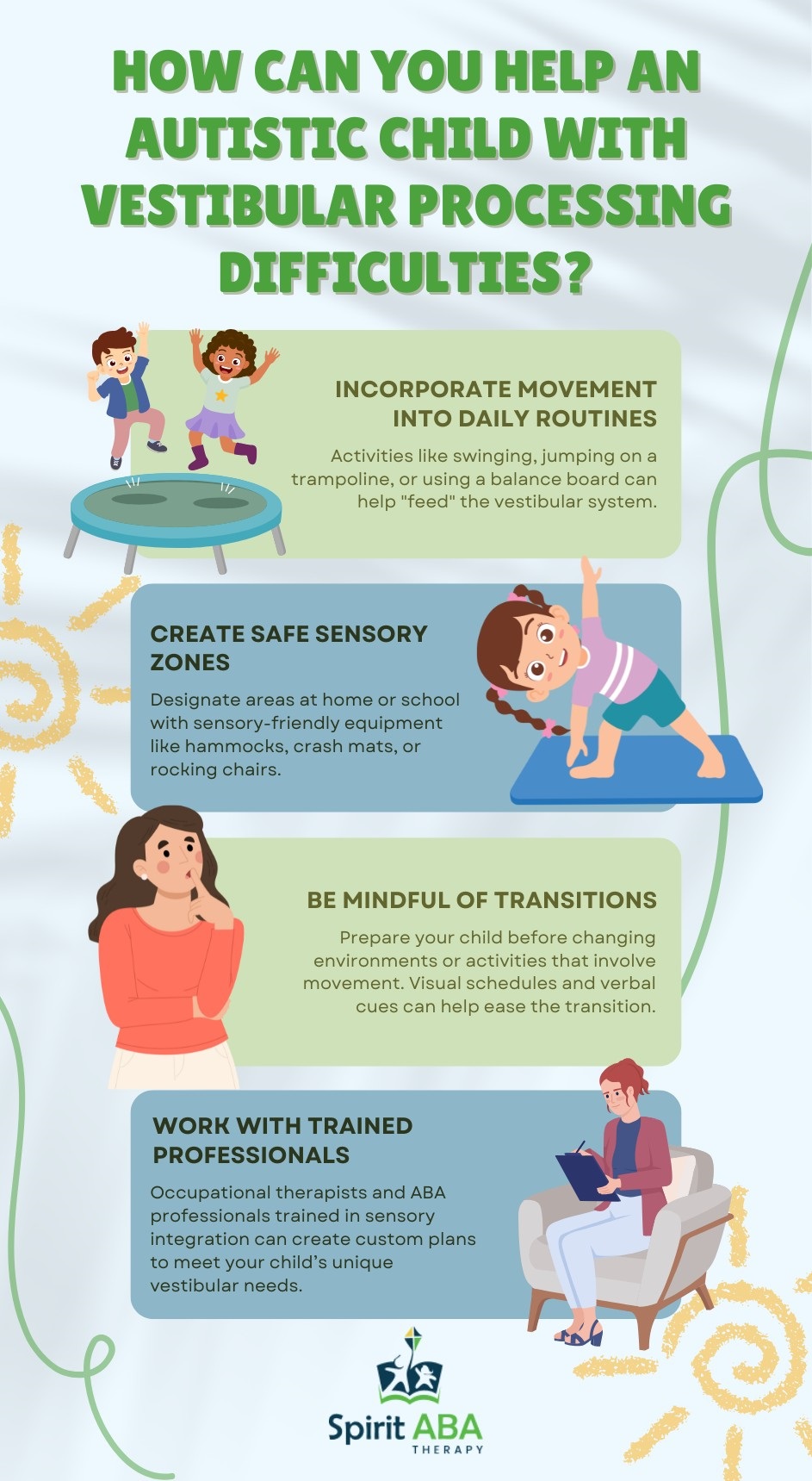Key Points:
- Vestibular issues are common in individuals with autism and can impact balance, coordination, and sensory regulation.
- These challenges are linked to how the brain processes movement and spatial orientation, often resulting in sensory-seeking or sensory-avoiding behaviors.
- Addressing vestibular dysfunction is key to improving daily function, learning, and emotional regulation in autistic individuals.
Parents often notice it first: the dizzy spells, the clumsiness, or that endless love for rocking chairs. These aren’t just cute habits—they might point to vestibular issues in autism. Understanding this sensory system can unlock a whole new level of insight into your child’s behaviors and needs.
Do Autism Vestibular Issues Exist in Autism?
Yes, autism and vestibular issues often go hand-in-hand. Many autistic individuals experience difficulties with balance, movement, and spatial awareness due to atypical processing in the vestibular system. These sensory differences can lead to behaviors like spinning, rocking, or extreme sensitivity to motion, signs of underlying vestibular dysregulation.

What Is the Vestibular System and Why Does It Matter in Autism?
Before diving deeper, it helps to understand what the vestibular system actually is. Nestled deep inside the inner ear, the vestibular system is responsible for processing motion, balance, and spatial orientation. In everyday terms, it’s what keeps us upright, coordinated, and aware of how we move through space.
For many autistic children, the vestibular system doesn’t function the way it does for neurotypical individuals. This can show up in different ways—some kids may crave movement constantly (think spinning, jumping, or running back and forth), while others may avoid it altogether because it feels overwhelming or disorienting. These behaviors are often clues pointing to vestibular dysfunction.
How Do Vestibular Issues Present in Autistic Individuals?
Vestibular issues in autism aren’t always obvious at first glance. They can look like behavioral quirks, but when observed closely, these behaviors usually serve a self-regulatory purpose. Understanding these signs helps caregivers provide better support.
Here are some of the most common signs of vestibular processing challenges in autism:
- Sensory Seeking Behaviors: Children may spin, rock, jump, or hang upside down frequently. These movements help them stimulate their under-responsive vestibular system.
- Sensory Avoidance: On the flip side, some children resist movement. They may hate swings, get car sick easily, or struggle with activities like climbing stairs or walking on uneven surfaces.
- Delayed Motor Skills: Vestibular dysfunction can interfere with gross motor development. You might notice clumsiness, frequent tripping, or difficulty with balance-intensive tasks like riding a bike.
- Postural Instability: Many autistic individuals have trouble maintaining an upright posture for long periods. This could result in slouching or fatigue during activities that require sitting or standing for extended periods.
- Disorientation or Dizziness: Some kids may report feeling dizzy, nauseated, or confused in situations that involve movement, especially quick or unpredictable movement.
Why Do Vestibular Issues in Autism Get Overlooked?
It’s surprisingly easy for vestibular issues to fly under the radar—especially in autism where there are so many other needs competing for attention. Communication difficulties can also make it harder for a child to express when something feels “off.”
Another reason? Vestibular dysfunction doesn’t always look the same. It’s not one-size-fits-all, which means symptoms vary from child to child. A kid who can’t stand playground swings may have the same core vestibular issue as one who won’t stop spinning in circles, but the behavior looks completely different on the surface.
This variability makes it crucial for therapists, educators, and parents to be observant and informed about sensory processing, especially when trying to decode behavioral patterns.
What Triggers Vestibular Dysregulation in Autistic Children?
Vestibular dysregulation in autism can be triggered by environmental factors, developmental delays, or co-occurring conditions. Knowing these triggers can help in creating supportive environments that reduce stress and overstimulation.
Here are some common vestibular stressors:
- Sudden Changes in Movement: Rapid changes like spinning, stopping abruptly, or being picked up can cause disorientation or distress.
- Unfamiliar Surroundings: New environments with stairs, elevators, or uneven surfaces may create a sense of imbalance or fear.
- Overcrowded or Noisy Spaces: Sensory-rich environments may overwhelm not just the auditory system but also the vestibular system, especially when movement is involved.
- Lack of Movement Opportunities: On the flip side, not enough sensory input can make some children irritable or disengaged because they’re not getting the vestibular stimulation they need.
Can Vestibular Dysfunction Affect Learning and Behavior?
Absolutely. When a child’s vestibular system is dysregulated, it doesn’t just affect physical movement—it also affects how they learn and interact with the world around them. Vestibular input plays a major role in self-regulation, focus, and even emotional control.
Imagine trying to sit still and listen to a story when your body feels like it’s on a moving boat. That’s what it can be like for a child with vestibular issues in a classroom setting. They might fidget, act out, or seem inattentive—not because they aren’t interested, but because their sensory system is struggling to stay grounded.
How Can You Help an Autistic Child With Vestibular Processing Difficulties?
Supporting a child with vestibular challenges means creating consistent routines and offering the right kind of movement experiences. Intervention doesn’t have to be complicated, but it does need to be intentional.
Here are a few ways to support vestibular regulation:

How Does ABA Therapy Fit Into the Picture?
While Applied Behavior Analysis (ABA) isn’t a direct sensory therapy, it can be an incredibly effective framework for helping children learn adaptive responses to sensory challenges—including vestibular ones. ABA therapy focuses on behavior, but that doesn’t mean it ignores the “why” behind a behavior.
Through ABA strategies, therapists can:
- Teach coping skills for dealing with vestibular overload
- Reinforce positive responses to movement-based activities
- Use data-driven analysis to understand sensory triggers and patterns
- Collaborate with occupational therapists to integrate sensory-friendly goals
ABA therapy also allows for highly individualized support, meaning your child isn’t expected to conform to a cookie-cutter program. Instead, the plan adapts to their needs, preferences, and developmental level.
When Should You Seek Help for Vestibular Issues?
It’s never too early—or too late—to seek support. If your child shows signs of discomfort with movement, delays in coordination, or unusual sensory behaviors that interfere with daily life, it’s worth exploring further.
You can start by:
- Talking to your pediatrician or a developmental specialist
- Requesting an evaluation from an occupational therapist
- Connecting with an ABA provider who understands sensory differences in autism
ABA Therapy in Colorado, Iowa and Nebraska — Start Supporting Your Child’s Journey
If your child is showing signs of vestibular processing challenges, early intervention can make all the difference. At Spirit ABA, we specialize in creating behavior-focused, individualized therapy programs that meet children where they are—sensory needs and all.
Whether your child craves constant movement or avoids it completely, our ABA therapists can help them develop the tools they need to self-regulate, engage meaningfully, and thrive in daily life.
Looking for ABA therapy in Nebraska, Colorado, and Iowa? Contact Spirit ABA today and find out how our compassionate, evidence-based approach can support your child’s growth and independence.


